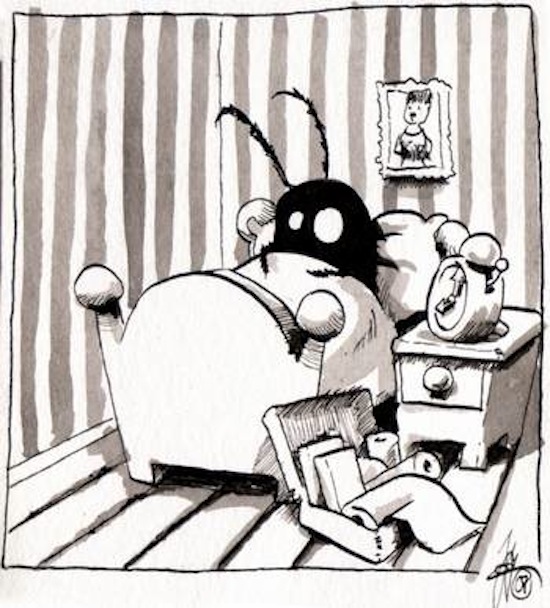
Men Without Women
Stories
Haruki Murakami
Philip Gabriel, Ted Goossen,
Translators
(Alfred A. Knopf)

I first went gaga about Haruki Murakami about fifteen years ago when I read "Super-Frog Saves Tokyo." I reported that I'd always been quite fond of frogs, especially ones that could talk, especially one that, when we addressed him as "Mr. Frog" says "Please --- just call me Frog.""It's a sweet Kafka parable," I wrote, "without the Kafkaesque morbidity. Like Kafka, our writer allows us to visualize the creature, but imperfectly. We see him through a frog I mean a fog of brevity:"
Katagiri found a giant frog waiting for him in his apartment. It was powerfully built, standing over six feet tall on its hind legs.
"Mr. Frog --- that is, Frog --- tells him that there is a creature named Worm who lives below Tokyo, right under where Katagiri works in the bank. Frog has found out that Worm is going to wake from a long sleep and start moving which will cause an earthquake that will kill 150,000 people. He and Katagiri have to stop it." Since then I have plowed through many of the author's books, never disappointed. At least until now.
§ § § So what's with Men Without Women. First, two of these stories - - - "Kino" and "Yesterday" appeared in previous collections. They are OK . . . but not Murakami at his most powerful out-of-left-field best. Further, "Drive My Car," the first story, is almost didactic, and you know how I react to someone trying to tell me something instructive (rather than the author's usual trope, being pure zany). The message: if you are an actor, you can leave reality to play your part to the hilt - - - but remember, when you do, you will come back to the real you changed. E. g.: You can never step in the same stream twice.
I blame the problem in the present volume on the editor because as I got towards the end, I found the last few tales to be champion Murakami, the same guy who could create a tall green character figure out why Tokyo has earthquakes."
Take "Samsa in Love," hidden here at the end . . . story number six out of seven. Yes, it's the same Gregor, dreamed up by another author, but this one wakes up to find himself, gack, a human. Which fills him with dismay at what he sees in the mirror:
Worse than ill-formed. It possessed no means of self defense. Smooth white skin (covered by only a perfunctory amount of hair) with fragile blue blood-vessels visible through it; soft unprotected belly; ludicrous, impossibly shaped genitals; gangly arms and legs (just two of each!) . . .
Gregor learning to walk is a laugh riot but best of all is his unexpected visitor, a locksmith. A lady locksmith. She had been sent by her locksmith brothers because there was a "disturbance" that day in Prague, some kind of invasion. Tanks and soldiers and guns. We don't have to be told the date.
She's a hunchback lady locksmith, laboring up the stairs, "much like a crawling insect. Samson labored after her, his hand on the railing. Her creeping gait aroused his sympathy - - - it reminded him of something." Sweet Murakami. He doesn't need to nail down that elegant "something." He trusts the reader; we know.
Best of all, the dialogue. Here she is, working to fix the lock on the door to his room. His family has reasons, and we all know what they are, to keep him under lock and key.
Samsa made up his mind. "May I ask you a question?" he said.
"A question?" she said, casting him a dubious glance. "I can't imagine what, but go ahead."
"Why do you twist about like that every so often?"
She looked at Samsa with her lips slightly parted. "Twist about?" She thought for a moment. "You mean like this?" She demonstrated the motion for him.
"Yes, that's it."
"My brassiere doesn't fit," she said dourly. "That's all."
"Brassiere?" Samsa said in a dull voice. It was a word he couldn't call up from his memory.
"A brassiere. You know what that is, don't you?" the woman said. "Or do you find it strange that hunchback women wear brassieres? . . . Listen up. We hunchbacks have two breasts, just like other women, and we have to use a brassiere to support them. We can't walk around like cows with our udders swinging."
§ § § My advice to you. If you buy Men Without Women, and I recommend you do, now - - - and don't confuse it with Hemingway's collection from 1927 for chrissakes - - - you must start at the back and work yourself towards the front. Just like I do with The New Yorker. So I don't have to plow through all that trash at the beginning.
And don't forget to thank me when you do. For saving you so much wasted effort, and having such a good time in the process.